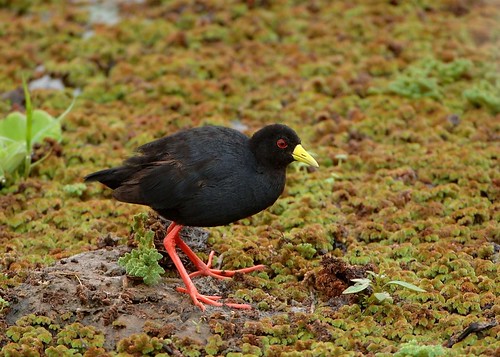tags: Black Crake, Amaurornis flavirostris, birds, mystery bird, bird ID quiz
[Mystery bird] Black Crake, Amaurornis flavirostris, photographed at Amboseli National Park, Kenya, Africa. [I will identify this bird for you in 48 hours]
Image: Dan Logen, 6 August 2006 [larger view].
Nikon D2X, ISO 200, 200-400 VR lens at 400 mm. 1/180 sec, f/4.
Please name at least one field mark that supports your identification.


Definitely in the family Rallidae (strong legs, long toes, short rounded wings)...
Short tail, long toes, black plumage, red legs and feet, yellow bill (flavirostra in binomial name), endemic to sub-Saharan Africa and widespread in souther Kenya, so:
Black Crake, Amaurornis flavirostra
Black Crake
The only question now is what gender- apparently most males, but only 10% of females, have a hooked upper mandible and as compared to the photo inserted below which indicates that the upper mandible is not longer than the lower one (and therefore I must assume female), the photo above shows a distinctly longer upper mandible and so it is very likely a male...
female Black Crake
oops, Amaurornis flavirost-ris
ummm, Grrl- please see #3...
I am aware (as in comment #1), that a mismatch genus-species name exists for the Black Crake, but there are numerous examples of the gender-matched name...
the ICZN states that there should be "agreement in grammatical gender between a generic name and Latin or latinized adjectival or participial species"...
surely then, it must be Amaurornis flavirostris